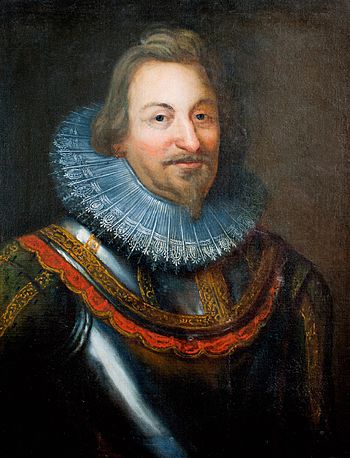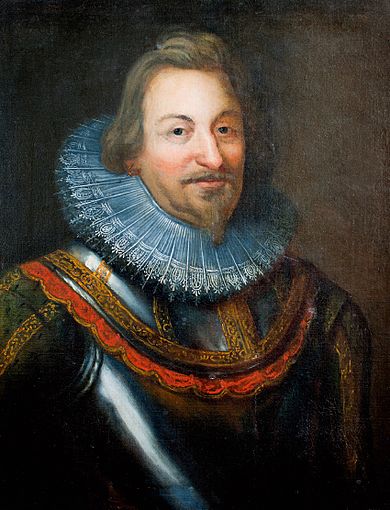Donogh O'Brien, 4th Earl of Thomond facts for kids
Quick facts for kids
Donogh O'Brien
|
|
|---|---|
| Earl of Thomond | |
|
Detail. See full portrait further down
|
|
| Tenure | 1581–1624 |
| Predecessor | Conor, 3rd Earl |
| Successor | Henry, 5th Earl |
| Died | 5 September 1624 Clonmel |
| Spouse(s) |
|
| Issue Detail |
Henry, Barnabas, & others |
| Father | Conor, 3rd Earl of Thomond |
| Mother | Una O'Brien-Arra |
Donogh O'Brien (died 1624) was an important Irish nobleman and soldier. He was the 4th Earl of Thomond and also known as Baron Ibrickan. He was a Protestant and served Queen Elizabeth I of England.
Donogh fought in a big war called Tyrone's Rebellion. He also took part in the Siege of Kinsale, a very important battle. He helped move his family's land, County Clare, from one part of Ireland (Connacht) to another (Munster). In 1605, he became the president of Munster, which meant he was in charge of that area.
Contents
Donogh's Family and Early Life
Donogh O'Brien was born in the 1560s. He was the oldest son of Conor O'Brien, who was the 3rd Earl of Thomond. His mother was Una O'Brien-Arra.
His family, the O'Briens, were a very old Irish family. They were descendants of Brian Boru, a famous medieval high king of Ireland. Donogh's mother's family also came from a branch of the O'Brien family.
Donogh grew up at the court of Queen Elizabeth I in England. This is why he became a Protestant. He was already known as Baron Ibrickan by 1577.
| Family tree | |||||||||||||||||||||||||||||||||||||||||||||||||||||||||||||||||||||||||||||||||||||||||||||||||||||||||||||||||||||||||||||||||||||||||||||||||||||||||||||||||||||||||||||||||||||||||||||||||||||||||||||||||||||||||||||||||||||||||||||||||||||||||||||||||||||||||||||||||||||||||||||||||||||||||||||||||||||||||||||||||||||
|---|---|---|---|---|---|---|---|---|---|---|---|---|---|---|---|---|---|---|---|---|---|---|---|---|---|---|---|---|---|---|---|---|---|---|---|---|---|---|---|---|---|---|---|---|---|---|---|---|---|---|---|---|---|---|---|---|---|---|---|---|---|---|---|---|---|---|---|---|---|---|---|---|---|---|---|---|---|---|---|---|---|---|---|---|---|---|---|---|---|---|---|---|---|---|---|---|---|---|---|---|---|---|---|---|---|---|---|---|---|---|---|---|---|---|---|---|---|---|---|---|---|---|---|---|---|---|---|---|---|---|---|---|---|---|---|---|---|---|---|---|---|---|---|---|---|---|---|---|---|---|---|---|---|---|---|---|---|---|---|---|---|---|---|---|---|---|---|---|---|---|---|---|---|---|---|---|---|---|---|---|---|---|---|---|---|---|---|---|---|---|---|---|---|---|---|---|---|---|---|---|---|---|---|---|---|---|---|---|---|---|---|---|---|---|---|---|---|---|---|---|---|---|---|---|---|---|---|---|---|---|---|---|---|---|---|---|---|---|---|---|---|---|---|---|---|---|---|---|---|---|---|---|---|---|---|---|---|---|---|---|---|---|---|---|---|---|---|---|---|---|---|---|---|---|---|---|---|---|---|---|---|---|---|---|---|---|---|---|---|---|---|---|---|---|---|---|---|---|---|---|---|---|---|---|---|---|---|---|---|---|---|---|---|---|---|---|---|---|---|---|---|---|---|---|---|
|
|||||||||||||||||||||||||||||||||||||||||||||||||||||||||||||||||||||||||||||||||||||||||||||||||||||||||||||||||||||||||||||||||||||||||||||||||||||||||||||||||||||||||||||||||||||||||||||||||||||||||||||||||||||||||||||||||||||||||||||||||||||||||||||||||||||||||||||||||||||||||||||||||||||||||||||||||||||||||||||||||||||
Donogh's Marriages and Children
Donogh O'Brien married twice. His first wife was Helen Roche. Her family was known as "Old English" and was Catholic.
Donogh and Helen had one daughter:
- Margaret, who married Charles MacCarthy, 1st Viscount Muskerry. Their son was Donough MacCarty, 1st Earl of Clancarty.
Helen died in 1583.
Later, around 1588, Donogh married his second wife, Elizabeth FitzGerald. She was the daughter of Gerald FitzGerald, 11th Earl of Kildare.
Donogh and Elizabeth had two sons:
- Henry (1588–1639), who became the 5th Earl of Thomond after his father.
- Barnabas (died 1657), who became the 6th Earl of Thomond after his brother.
Elizabeth died in 1617.
Becoming Earl of Thomond
When his father died in 1581, Donogh became the 4th Earl of Thomond. By 1582, he had returned to Ireland. He worked closely with the English government in Ireland.
In 1584, he helped create an agreement to change how land was passed down in Connacht. This agreement ended old Irish customs like tanistry (where a chief was chosen, not inherited) and partible succession (where land was divided among heirs). Instead, a tax was put on land.
He also attended the Irish Parliament between 1585 and 1586.
Fighting in Tyrone's Rebellion
In 1595, a major conflict called Tyrone's rebellion (also known as the Nine Years' War) began. Donogh played a big part in helping the English stop it.
He led a large army and entered Hugh Roe O'Donnell's territory in July 1595. He had to retreat when a peace agreement was signed. He was later sent to defend Newry.
In 1597, he served in a military campaign. But early in 1598, he went to England and stayed at Queen Elizabeth's court for most of the year.
Because he was in England, he missed the Battle of Yellow Ford in August 1598. In this battle, Hugh O'Neill, Earl of Tyrone defeated the English army. After this defeat, some people in Donogh's own area, Clare, started to rebel. His brother, Teige O'Brien, even joined the rebels. This meant Donogh's youngest brother, Daniel, had to defend their lands.
In 1599, O'Donnell invaded Clare, destroying the land and capturing many castles. Daniel was taken prisoner. Donogh's brother Teige was imprisoned for rebelling, then released, but later joined another invasion of Clare and was killed.
Donogh returned from England and gathered his forces. He then invaded Clare to get back his family's lands. He used cannons from Limerick to attack castles that resisted. He quickly recaptured them. The rebels were completely driven out of Clare.
In 1599, Donogh also traveled with Robert Devereux, 2nd Earl of Essex, who was a powerful English leader. Donogh was made governor of Clare and became a member of the Privy Council of Ireland (a group of advisors to the ruler).
In 1600, Donogh was very busy with the war. He was involved in a meeting where a fight broke out, and he helped save Sir George Carew from being captured. He was wounded himself.
He also helped defeat Florence MacCarthy Reagh and was present when he surrendered. Donogh continued to command in Clare and fought against O'Donnell's raids. He met with the Lord Deputy (the Queen's main representative in Ireland) and marched to stop Tyrone's army, but no major battle happened.
In 1601, Donogh went to England again. He wanted to become the governor of Connacht and to have Clare officially moved into the province of Munster. He returned to Ireland in November 1601 and played a key role in the Siege of Kinsale. After Kinsale surrendered, he helped lead the army through Munster and was in command at the siege of Dunboy.
Donogh was with the army until June 1602. He then visited England again. As a reward for his loyalty, his request to move Clare to Munster was granted, even though some Irish officials disagreed. He returned in October 1602.
In 1603, he became a member of the Irish Privy Council. In 1605, he was appointed President of Munster, a very important position.
Later Life and Legacy
In 1613, Donogh attended the Irish House of Lords in the Irish Parliament. He strongly supported the Protestant side in debates about choosing the speaker for the Irish House of Commons.
In 1619, he was reappointed governor of Clare. He also helped Florence MacCarthy Reagh, who had been in prison since 1600. MacCarthy dedicated his book on Irish history to Donogh.
Donogh O'Brien died on September 5, 1624, in Clonmel. He was buried in Limerick Cathedral, where a monument was built to remember him.
People remembered Donogh as one of the most important and strong Irish loyalists (people loyal to the English Crown). Even though some doubted his motives, one English official said that Donogh's service came from a "true nobleness of mind."
| Timeline | ||
|---|---|---|
| Since Donogh's exact birth year is not known, the ages listed are estimates. | ||
| Age | Date | Event |
| 0 | 1560, estimate | Born |
| 17 | 1577 | Mentioned as Baron Ibrickan |
| 21 | 1581 | Became 4th Earl of Thomond |
| 28 | 1588 | Son Henry born |
| 30 | 1590, about | Daughter Margaret married Charles MacCarthy, 1st Viscount Muskerry |
| 35 | 1595 | Tyrone's Rebellion began |
| 41 | 1601, 11 Nov | Landed at Castlehaven and went to Kinsale |
| 43 | 1603, 30 Mar | Treaty of Mellifont ended Tyrone's Rebellion |
| 45 | 1605, 6 May | Appointed President of Munster |
| 64 | 1624, 5 Sep | Died in Clonmel |



